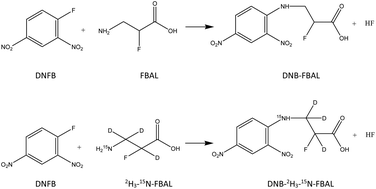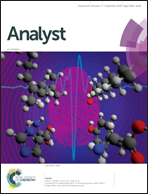Biomonitoring of occupational exposure to 5-FU by assaying α-fluoro-β-alanine in urine with a highly sensitive UHPLC-MS/MS method
Abstract
5-Fluorouracil (5-FU) is one of the most widely used antineoplastic drugs handled by healthcare professionals (HCP). To monitor occupational exposure to 5-FU, a highly sensitive ESI-UHPLC-MS/MS method was developed for the assay of its main human metabolite, α-fluoro-β-alanine (FBAL), in urine. After a derivatization step, solid phase extraction was used for the urine. Good linearity (r > 0.996), precision (CV < 14.76%), and accuracy (bias < 12.16%) were achieved. The lower limit of quantification (LOQ), 20 pg ml−1, is the lowest one published to date. Seven urine samples from 73 HCP exposed to 5FU were positive for FBAL, indicating 5FU contamination (9.6%). FBAL urine concentrations ranged from 25 to 301 pg ml−1. Such an efficient analytical tool combining high specificity with high sensitivity is essential for the reliable detection and routine biological monitoring of healthcare professionals occupationally exposed to this widely used antineoplastic drug. This method allows biomonitoring of occupational exposure to 5-fluorouracil in a routine manner, with the aim of assessing the effectiveness of collective and individual protective measures.



 Please wait while we load your content...
Please wait while we load your content...